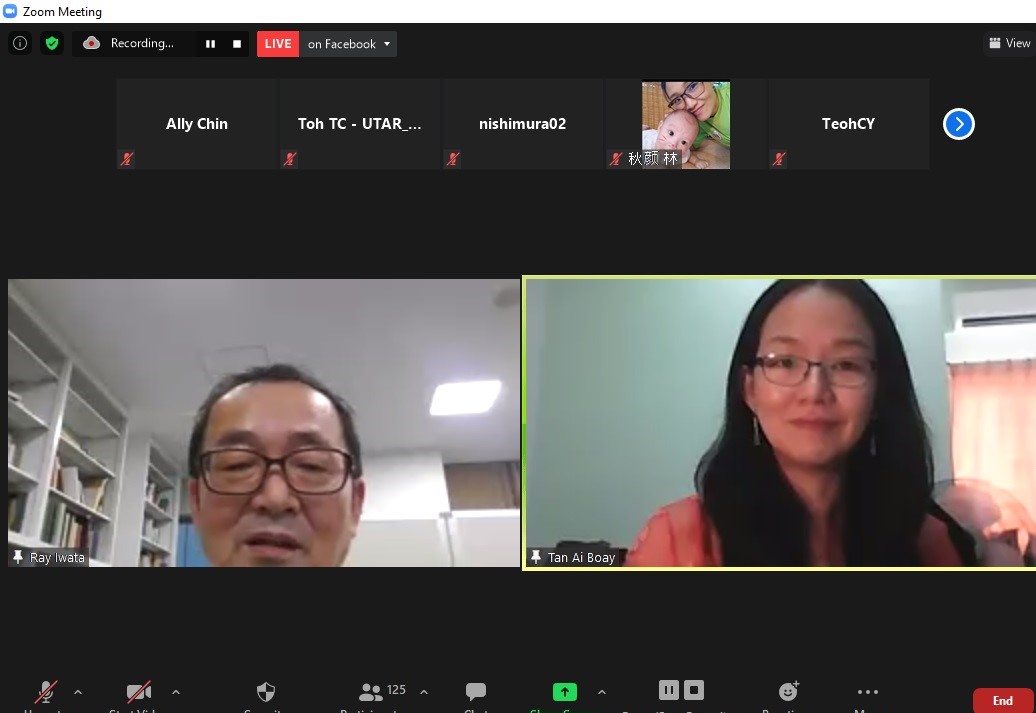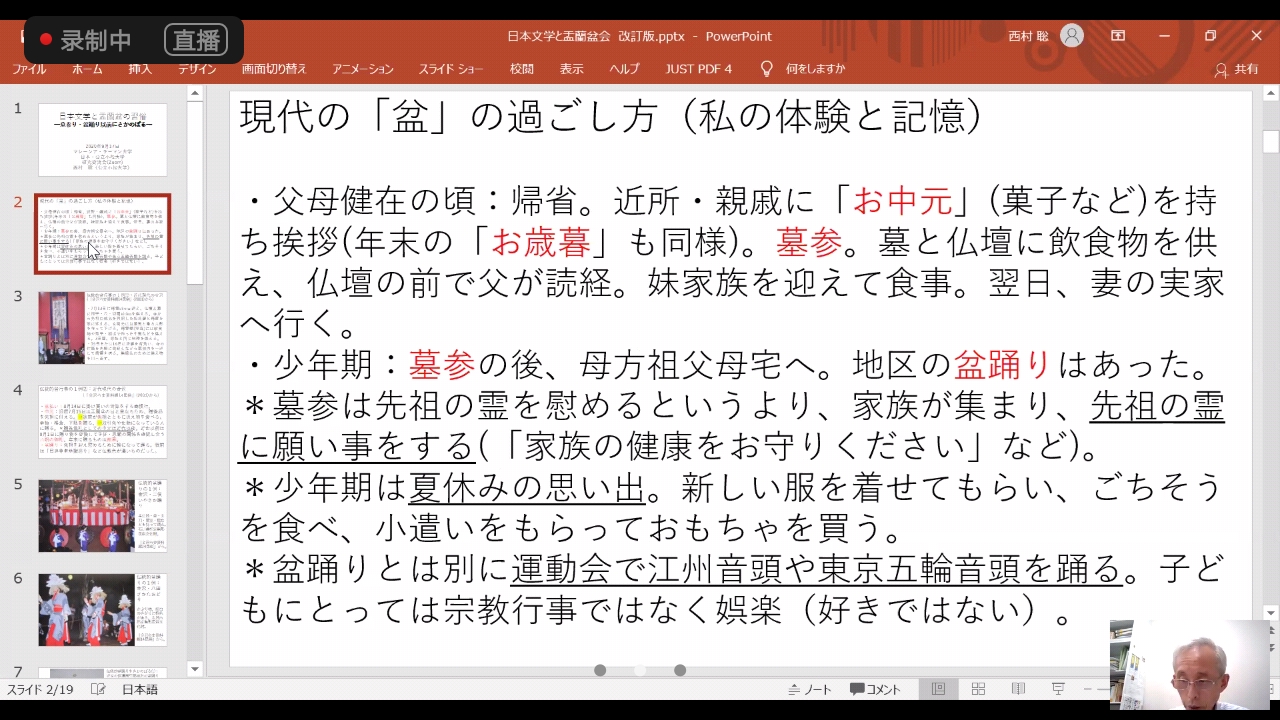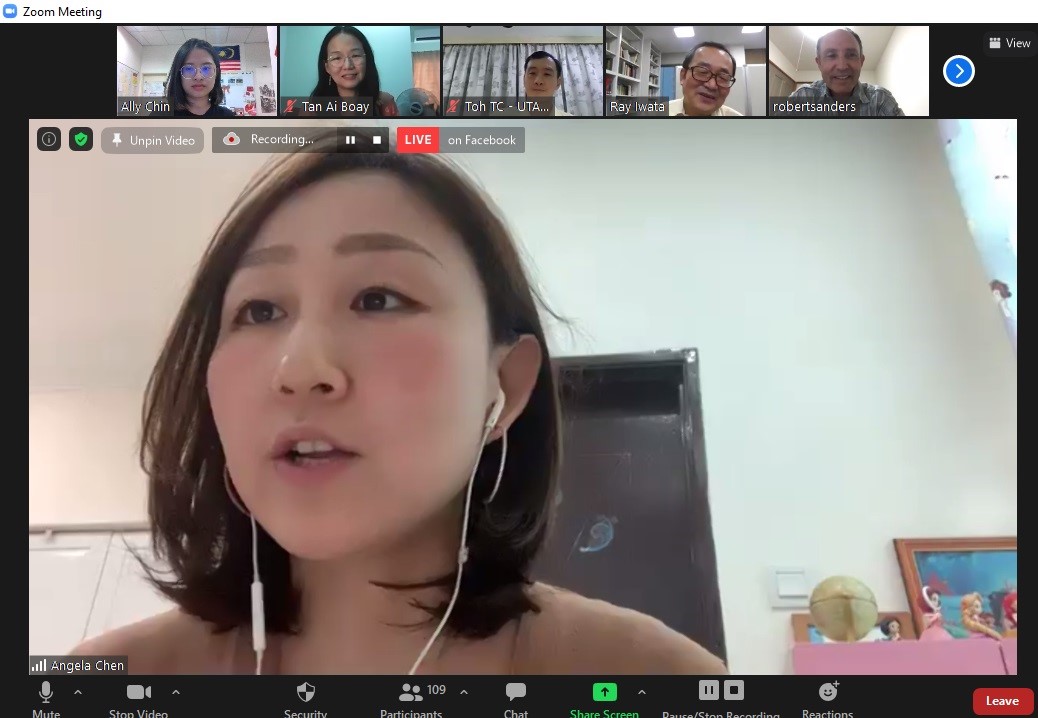
The similarities and differences between Zhongyuan Festival and Obon Festival

Dr Toh (left) explaining the Zhongyuan Festival in Malaysia, while Prof Nishimura explains the Obon Festival in Japan
UTAR and Komatsu University (KU), Japan jointly organised a webinar on “The Variation of Zhongyuan Festival and Obon Festival: Comparison of Customs in Malaysia and Japan” (中元节及盂兰盆节的时空变异:马来西亚和日本的习俗比较) on 17 September 2020 via Zoom.
The webinar was conducted by UTAR Institute of Chinese Studies (ICS) of Kampar Campus Department of Chinese Studies Head Dr Toh Teong Chuan and KU Faculty of Intercultural Communication Department of Intercultural Communication Prof Dr Satoshi Nishimura. The emcee for the session was ICS Postgraduate Degree Programmes Head Dr Tan Ai Boay, and the moderator-cum-interpreter was KU Faculty of Intercultural Communication Department of Intercultural Communication Dean Prof Dr Ray Iwata.

Prof Iwata (left) as the moderator-cum-interpreter and Dr Tan as the emcee
This webinar is a result of collaboration between UTAR and KU after the signing of memorandum of understanding (MoU). With the aim to promote exchange among academics and students between both universities, the webinar saw the participation of 167 participants from both universities. Prof Iwata thanked UTAR for the arrangement and said, “UTAR and KU have signed an MoU last year to formally establish a partnership between both universities. However, due to the Covid-19 pandemic, the originally planned study tour had to be postponed and face-to-face exchange was arranged through online platform.” He also encouraged students to join the student exchange programme after the pandemic to gain the opportunity to learn in a different country and environment to broaden their horizons.

Dr Toh explaining the origin of the Zhongyuan Festival from the view of the Confucianism, Buddhism and Taoism
Dr Toh introduced the origin of the Zhongyuan Festival, followed by the Zhongyuan of Taoism and the Yulan Festival of Buddhism. Meanwhile, he also shared Malaysia’s Zhongyuan celebration and custom to provide the participants, especially those from KU, a deeper understanding of the Zhongyuan Festival which is celebrated by the Chinese and also the celebration among Malaysian Chinese.
He explained, “The mid-July of Chinese lunar calendar is a religious and cultural festival celebrated by Confucianism, Buddhism and Taoism, and the festival has been named as Autumn Ritual (秋祭) in Confucianism, Ullambana/ Yulan Festival (盂兰盆) in Buddhism and Zhongyuan Festival (中元节) in Taoism. It is also generally called as Pudu/Podo (普渡; literally translated as a “common crossing”) or Ghost Festival among the Chinese community. The people have a certain misunderstanding about the Zhongyuan Festival as the Ghost Festival, but in fact from the view of the essence of the Confucianism, Buddhism and Taoism, the origin of the Zhongyuan Festival in mid-July is actually a day of filial piety.” He also shared the allusions of the festival such as Confucian Ancestor Worship, the Spirit of Filial Piety of Emperor Shun, Earth Official (地官) Pardons Sins, Mulian Rescues His Mother, and Transference of Merits (功德回向) to the ancestors during Kathina day to highlight the core of filial piety that are embodied in Confucianism, Buddhism and Taoism.

Zhongyuan Festival celebration among Malaysian Chinese community
“Zhongyuan celebration among the Malaysian Chinese was developed into a local festival and it was based on the ethnic’s belief and worship culture. It embodies both the cultural heritage of the origin and also the self-improvement spirit rooted in the local culture, such as the annual education fundraising activities organised in Penang during the Zhongyuan celebration, which cannot be found anywhere else,” he added.

Prof Nishimura sharing his experience on how his family celebrates the Obon Festival
On the other hand, Prof Nishimura introduced the origin of Japan’s Obon (お盆) Festival celebration and its custom. He shared his own experience on how modern Japanese celebrates the Obon Festival and said, “Obon Festival is a summer celebration which is equally important to the New Year’s celebration, and a summer festival for honoring ancestors. The Japanese will bring along snacks and gifts (御中元) to visit their ancestors’ graves (上坟). Besides that, some families would invite a Buddhist monk to their home or visit a temple to recite the sutras. For the modern Japanese, visiting the cemetery does not only serve the purpose of performing memorial services and comforting the ancestors’ soul, but it also helps to gather and unite the family. It is also a time for the present generations to pray to their ancestors so that their wishes can be realised. Obon Festival is also the gift-giving season for the Japanese; they will offer gifts to social superiors and customers to express their gratitude to the important people in their lives and businesses. The gift-giving custom was developed after the Meiji Restoration Era.”

Bon Odori is a type of dance performed during the Obon Festival
Moreover, he explained the origin of Bon Odori (盆踊) and its allusion. He said, “Bon Odori is a type of dance performed during the Obon Festival to comfort the ancestors. It requires people to stand in a circle to perform this dance. In this modern days, the custom of visiting ancestors' graves still remains, however the Bon Odori no longer flourished like it did before and has leaned towards regional festivals or has turned into tourism resources. Bon Odori before the war (World War II) had strong Buddhist influence. One of the famous themes for the dance was ‘Mulian Rescues His Mother’, a famous Buddhist story.” He further explained the short history of Buddhism in Ancient Japan, the Buddhist culture, the custom of visiting ancestors’ graves and allusions to the Odori Festival.
During the Q&A session, the speakers exchanged with participants from both universities topics related to the similarities and differences between traditional celebration of the Chinese and Japanese, festival’s taboo, sacrificial offering, young people’s attitude towards traditional festivals and others.

Dr Chen thanking the speakers and participants
UTAR DCInterNet Deputy Director Dr Chen I-Chi expressed her gratitude to both institutions and said, “Thanks to both speakers for the insightful sharing and we hope there will be more opportunities to hold similar events again in the future. Most importantly, we are looking forward to the collaborations between both institutions and welcome KU’s students and academics to visit Malaysia and UTAR after the pandemic ends.”

The webinar received great response from UTAR and KU participants
![]()
![]()
© 2020 UNIVERSITI TUNKU ABDUL RAHMAN DU012(A).
Wholly owned by UTAR Education Foundation Co. No. 578227-M LEGAL STATEMENT TERM OF USAGE PRIVACY NOTICE